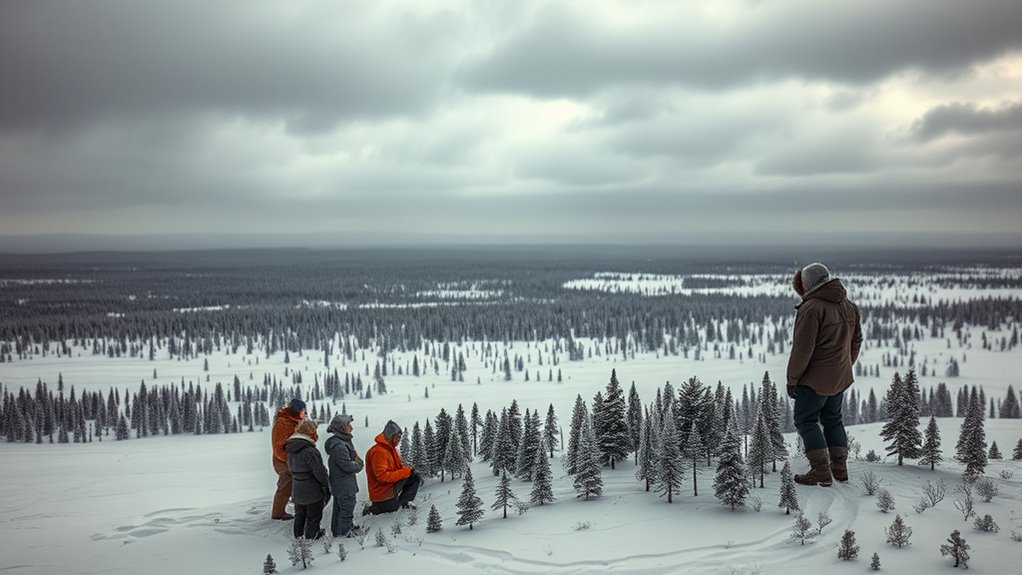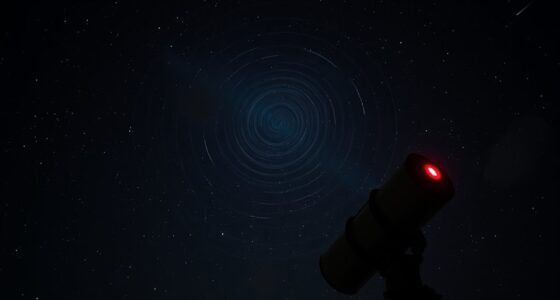Researchers use advanced explosion models to recreate the 1908 Tunguska event, helping you understand how a meteoroid about 50 to 60 meters wide exploded over Siberia with a force equivalent to 10-15 megatons of TNT. These simulations show how atmospheric entry caused the explosion, even without leaving a crater. By studying these models, you can see how small space objects have powerful impacts, and there’s more to uncover about this mysterious event.
Key Takeaways
- Researchers use advanced explosion modeling to recreate the 1908 Tunguska blast and understand its dynamics.
- Simulations indicate a meteoroid approximately 50-60 meters wide, traveling at about 15 km/sec, caused the explosion.
- Modeling helps visualize the atmospheric disintegration and explosion effects that prevented an impact crater formation.
- Incorporating satellite, seismic, and eyewitness data improves the accuracy of the simulated event.
- These studies enhance understanding of cosmic impact risks and inform planetary defense strategies.

Have you ever wondered what caused the massive explosion over the Siberian Taiga in 1908? The Tunguska event remains one of the most intriguing mysteries in modern history. Scientists believe it was triggered by a meteoroid impact, but the nature of the explosion and its incredible force have puzzled researchers for over a century. To better understand what happened, experts turn to explosion modeling—sophisticated simulations that recreate the blast’s dynamics based on available data. These models help them visualize how a meteoroid hurtling through space could unleash such devastation, even without creating an impact crater. By inputting variables like meteoroid size, velocity, and angle, researchers can simulate the explosion’s spread, intensity, and effects on the surrounding environment. This process allows them to test different scenarios and narrow down the most plausible explanation for the event.
Explosion modeling has revealed that a meteoroid approximately 50 to 60 meters wide probably entered Earth’s atmosphere at an estimated 15 kilometers per second. As it descended, the object heated up due to intense friction, eventually exploding in the atmosphere before reaching the ground. The explosion released energy equivalent to between 10 and 15 megatons of TNT, enough to flatten a vast forest over an area of 2,150 square kilometers. Interestingly, no impact crater was found, supporting the idea that the meteoroid disintegrated high in the atmosphere. This high-altitude explosion caused a shockwave that circled the globe, and the resulting blast wave knocked over trees and shattered windows hundreds of miles away.
Scientists have refined their explosion modeling techniques over the years, incorporating new data from satellite images, seismic records, and eyewitness accounts. These advancements help them better understand not only the Tunguska event but also how similar meteoroid impacts could threaten Earth today. Their simulations underscore how a relatively small space rock can unleash enormous energy upon atmospheric entry, emphasizing the importance of planetary defense. By studying explosion modeling in detail, researchers continue to piece together the puzzle of the Tunguska event, bringing us closer to understanding the potential risks posed by near-Earth objects. In the end, these efforts serve as a reminder of how much power lies in the cosmos and the importance of preparing for the unexpected.
Frequently Asked Questions
What Was the Exact Size of the Object That Caused the Explosion?
You should know that the meteoroid responsible for the Tunguska explosion was roughly 50 to 60 meters in diameter. Its dimensions played a key role in the explosion’s magnitude, estimated at 10 to 15 megatons of TNT. Although smaller than a city block, this size was enough to cause the massive blast that flattened trees over 800 square miles, highlighting how even modest meteoroids can produce devastating effects upon atmospheric entry.
Could the Tunguska Event Happen Again Today?
The Tunguska event could happen again today, and it might be even more devastating. Thanks to advancements in planetary defense, scientists now monitor space for potentially hazardous objects. While atmospheric entry of a similar-sized asteroid is still possible, early detection allows for mitigation strategies. Staying vigilant, improving tracking technology, and developing deflection methods are vital to prevent another catastrophic explosion like the 1908 blast.
Are There Any Undiscovered Meteorite Fragments Left at the Site?
You won’t find many undiscovered meteorite fragments at the Tunguska site because the explosion burned or scattered them widely. Forest regeneration over the past century has obscured any remaining fragments, making detection difficult. Researchers believe most fragments either vaporized or blended into the environment. While some small pieces might still exist, the dense forest and natural growth make uncovering new meteorite fragments unlikely today.
How Did the Explosion Affect Local Wildlife and Ecosystems?
A forest lost in the fire, but nature’s resilience is remarkable. You’d find that the explosion disrupted animal migration patterns temporarily and caused widespread habitat damage. However, plants showed impressive resilience, rebounding over time. As the saying goes, “What doesn’t kill you makes you stronger.” The ecosystem gradually recovered, demonstrating nature’s ability to adapt and heal after such a powerful event.
What Technological Advances Aid Current Research Into Similar Events?
You benefit from advances in sensor technology and space debris tracking, which help identify and analyze potential impact threats. Modern radar and satellite systems detect incoming objects, while sensors monitor atmospheric changes caused by space debris. These technologies enable quicker response times and better understanding of explosion dynamics, ultimately improving our ability to predict, prepare for, and mitigate the effects of similar events on Earth.
Conclusion
So, even if it seems unlikely that we’ll ever witness a blast like Tunguska again, these simulations show we’re getting closer to understanding what happened. By recreating the event, researchers help us prepare for future threats—without the fear of a real catastrophe. It’s not about causing panic but about learning and staying safe. With each discovery, you can feel more confident that humanity’s on top of these mysteries, ready to protect us all.








